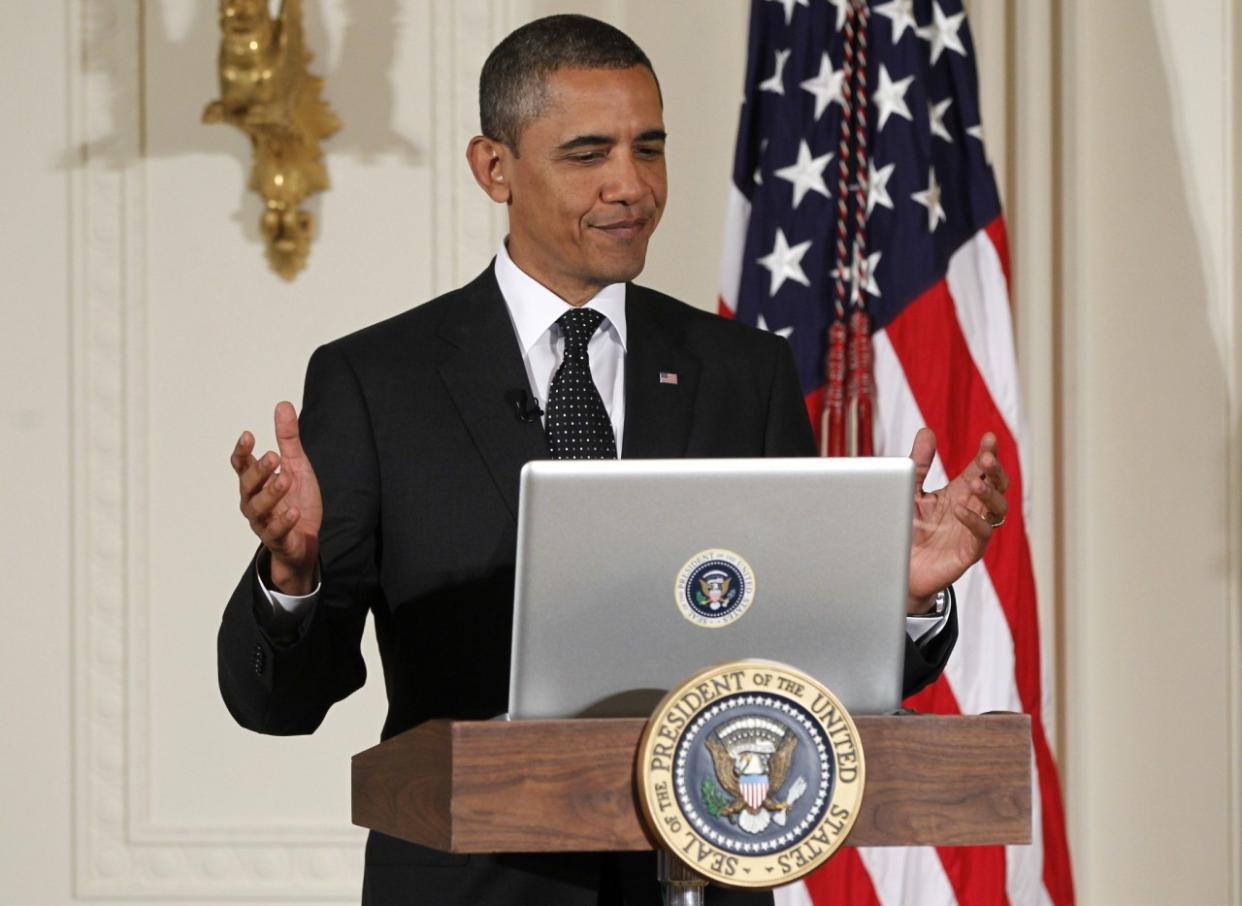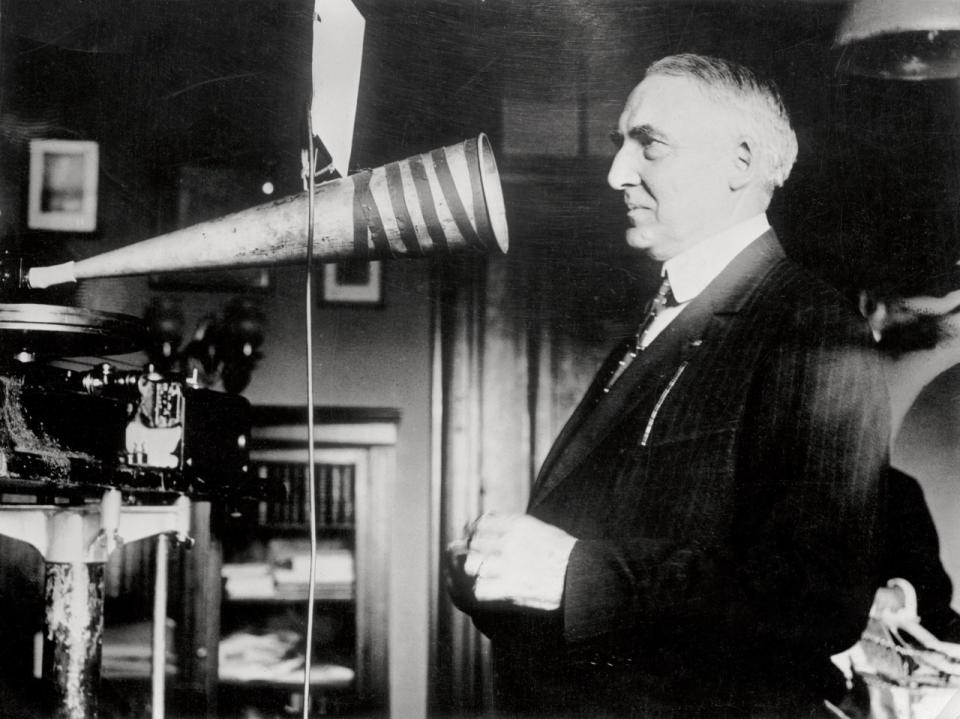The Last 100 Days: Dogs and Digital Edition

Ever since the administration of President Franklin Delano Roosevelt, presidents have been judged on the successes they notch during their first 100 days. Now, as Barack Obama prepares to end his historic turn on the political stage, Yahoo News is launching The Last 100 Days, a look at what Obama achieved during his consequential presidency, how he navigates the struggles of his final months in office and what lies ahead for him after eight years filled with firsts. And we will look at how the country bids farewell to its first African-American president.
It’s not a literal 100 days — Obama leaves office in late January 2017.
And it won’t all be about policy. As Obama himself is fond of noting, he also spent his two terms as father to daughters Malia and Sasha and husband to first lady Michelle Obama. And even without much input from the White House, the cultural landscape shifted dramatically over his two terms on issues such as gay rights.
And then there’s the way the president sees the presidency — not just his tumultuous years at 1600 Pennsylvania Avenue, but also the institution and its relationships (for better or worse) with other branches of government and with the news media.
In this third installment, we look at Obama’s legacy of expanding the White House’s message operation while frequently sidelining the news media.
_____
President Obama in January will hand his successor a formidable, sophisticated digital-messaging machine that skirts traditional news outlets to get his undiluted message directly to tens of millions of Americans. And he owes much of it to a frisky 2-year-old Scottish terrier.
In December 2002, George W. Bush’s dog Barney (RIP) bounded down a flight of red-carpeted steps, sauntered past Christmas trees in the East Room of the White House, and helped to forever transform the way U.S. presidents communicate with the public.
“Barneycam,” as the public relations coup came to be known, gave Americans what looked like a dog’s-eye view of Christmastime at the presidential mansion, closed to the public since the attacks of Sept. 11, 2001. Barney refused to actually wear a camera, so a crew from the White House Communications Agency chased George W. Bush’s beloved pet around to get the footage necessary for the five-minute video.
That scarcely mattered to Americans or the mainstream news media, which immediately fell hard for the canine-themed, kind-of-candid camera. Major television networks showed the video virtually in its entirety. Top tier print media, including international outlets, wrote it up as a novel and charming development. Bush aides recall marveling at the quantity of coverage from traditional news outlets for an in-house video, delighted that it reached tens of millions more Americans than it might have had it merely been featured on the White House website.
Even before he set foot in the White House, Obama had built on this legacy during his history-making 2008 campaign, enlisting a digital video team that didn’t just document his adventures on the trail but served as an arm of his communications apparatus — unfailingly portraying him in a flattering, or at least humanizing, light.
The point of acknowledging Bush’s contributions isn’t to blame him for the government propaganda machine that the next president will no doubt rely on to churn out favorable content while bypassing the press. Neither is it to credit Obama’s Republican predecessor for the revolutionary way in which this Democratic White House has embraced social media to tell its story to Americans directly.
Every president tries to harness emerging technologies while building on their predecessors’ communications successes and learning from their failures. And the presidents most associated with a given medium are rarely the ones who used it first. Obama’s unprecedented use of in-house media products drew on BarneyCam. Bush built his White House website thanks to Bill Clinton, who was the first to have an Internet presence. Clinton’s sax playing on the Arsenio Hall show owed a debt to Richard Nixon’s appearance on a 1968 episode of the comedy TV show “Laugh-In.” Every modern president has tried to put the commander in chief in front of striking backdrops, a nod to Ronald Reagan’s peerless imagemaking. If John F. Kennedy is remembered for having fully grasped television’s power in politics, it was Dwight D. Eisenhower who, years before, held the first televised press conference. Ike even won an Emmy in 1956. Every student of political communications learns about Franklin Roosevelt’s “Fireside Chats” on the radio, but far fewer know that Warren Harding was the first to use that medium.

Presidents and vice presidents of both parties have done interviews with specialized outlets — Bush’s chat with Runner’s World in 2002, for example. Obama’s digital-age version of this was undeniably a bit more eye-catching. He sat down to take questions from YouTube stars, including one best known for wearing green lipstick and getting into a bathtub of Fruit Loops, as part of a campaign to sell the public on Obamacare.
BarneyCam is as good a starting point as any for understanding the defining digital communication shifts of the Obama era. While this administration produces its in-house digital videos and graphics, it did not do so chiefly in the hope of getting mainstream media attention. Instead, it sought an online audience, starting with the official White House website. Later, with the proliferation of social media platforms, the administration designed its products to be shared via social media or third-party websites, where Americans increasingly get their news. Aides argue that they need to reach an audience that gets its information from an ever more diffuse set of outlets.
If the Ebola outbreak had taken place under Reagan, “he could have called a nationally televised address to say, ‘You’re not going to get Ebola,’ and that would have worked,” explains Dan Pfeiffer, who served as Obama’s communications director from late 2009 to early 2013. “We had to go to traditional press, but also Twitter, Facebook, Snapchat and other places where people get their news.”
Popular sites like Tumblr or YouTube give everyone a publishing platform, but the effect of lowering barriers to entry hasn’t all been democratizing. Powerful institutions with built-in audiences, like the White House, have seized on those platforms in a way that increases their power and diminishes the role of the press. (Disclosure: I sit on the board of the White House Correspondents Association, which pushes the White House for greater openness, information and access to policymakers, and defends the press corps’ interests.)
In the Bush era, staffers could monitor social media but were not supposed to interact with others there, chiefly because all communications with reporters, politicians and government officials are by law required to be archived.
The more clever White House communications aides, aware that reporters share thoughts with colleagues and readers on Facebook, kept track of those conversations using their personal devices — and in at least one instance, took issue (good-naturedly) with a writer’s portrayal of their policies.
Obama brought a more sophisticated Internet operation to the White House, created an Office of Digital Strategy, and set about conquering social media. Official social media accounts today note that any comments or conversations may be archived under the Presidential Records Act.
“If you look at the Obama era as January 2007 to January 2017, that decade will be the period of greatest change in how humans produce and consume information since the printing press,” Pfeiffer said. The administration, he said, went from worrying about what was on the front page of the Sunday New York Times to tracking what people share on Facebook.
By any measure, Obama’s social media presence has been astonishing.
On Facebook, more people worldwide talked about Obama in 2015 than about any other world leader. The White House video of Obama’s “anger translator” performance at the 2015 White House Correspondents Dinner was the most-watched Facebook video ever produced by a political organization in the United States.
Obama’s State of the Union drew about 31.7 million television viewers in 2015. But the White House’s 18 videos about the speech brought in about 26 million viewers.
As for Twitter, the @whitehouse account has 11.3 million followers. The official @POTUS presidential account has 9.98 million followers. The @barackobama account, created in 2007 and now run by his Organizing for America political advocacy group, has 76.8 million followers.
Other presidents have released pictures taken by the official White House photographer, but they only reached a sizable audience when picked up by the traditional news media. But Obama’s lensman, Pete Souza, regularly puts his work on Twitter or Flickr. Souza’s output has regularly generated friction between the White House and the press corps because many of his most memorable photos were exclusive — meaning that Obama’s press office excluded news photographers from the event. The same applies to “West Wing Week,” a slickly produced video account of the past seven days of policy and politics, frequently featuring events reporters never knew were taking place.

That means a considerable amount of Obama’s history comes to the public as visual press releases — in effect, propaganda. If you doubt the political usefulness of such a safe, friendly approach, consider that a number of Souza’s pictures appeared in the video of Obama’s endorsement of Hillary Clinton.
None of this has completely replaced the traditional media. Obama regularly does interviews with classic outlets, or more modern ones. He has gone one-on-one with Yahoo News three times in the past year.
“It’s always been clear to us that a strategy that was only produce your own content online and do Facebook town halls with Mark Zuckerberg would miss a large part of the American electorate,” Pfeiffer said. “A strategy that was only to do Rose Garden press conferences and talk to the Washington Post editorial board would also miss a large part of the American electorate.
“You are forced to do both,” he said.
Current and former Obama aides say the president is going where the audience is, and keeping in mind what it wants. As Yahoo News detailed in 2015, the White House crafts its strategy for the annual State of the Union speech to reach television watchers, Twitter scanners, Facebook friends, Reddit readers and people who use one or more at the same time.
The White House has also turned to social media as an early warning system for potentially bad coverage, notably via Twitter, as Yahoo News explained here. And where Bush aides officially had to hold back on Facebook, Obama’s communications team happily engages reporters and Republicans on Twitter.
Whoever wins the White House in November will inherit the precedents set by Obama in addition to the @POTUS Twitter handle. Like him, both Hillary Clinton and Donald Trump use a blend of social or new media and traditional outlets. Clinton favors interviews with individual reporters; Trump does those and also press conferences.
Clinton’s campaign recently bragged on Twitter that its podcast — the former secretary of state interviewed by someone on her payroll — had a larger audience than those of traditional news outlets.
In order words, it used social media to highlight a product made in-house, released to a mass audience through nontraditional means, reaching Americans without relying on the news media.
“The traditional tools available to a president have far less reach than eight years ago,” Pfeiffer said. “And whoever wins in November — hopefully the Democrat — by 2018, 2020, 2024, we’ll be talking about a whole different [medium] that you and I can’t imagine today.”
_____


